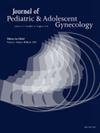45. FOXL2-induced BPES and POI with Hyperandrogenism and Normal Estradiol: A Clinical Conundrum
IF 1.8
4区 医学
Q3 OBSTETRICS & GYNECOLOGY
引用次数: 0
Abstract
Background
Patients with FOXL2 resulting in BPES (blepharophimosis, ptosis, epicanthus inversus syndrome) are at an increased risk of premature ovarian failure (POI). Hyperandrogenism alongside normal estradiol levels in the setting of POI is not noted in the literature.
Case
A 15-year-old female with a known history of FOXL2 gene and BPES presented to pediatric gynecology (PAG) due to secondary amenorrhea after experiencing only one episode of menses at age 12. Thelarche occurred at age 9 and prior workup was notable for elevated free and total testosterone, DHEAS, and FSH. She had a prior normal estradiol, prolactin, karyotype, 21-hydroxylase antibodies, thyroid antibodies, and Fragile X screen. Her physical exam was remarkable for tanner 4 tuberous breast and thick course hair on the face, check, and back consistent with hirsutism. Repeat FSH remained extremely elevated and estradiol remaining within normal pubertal range. Given persistent androgen excess on labs and physical exam findings, a pelvic ultrasound and CT abdomen/pelvis was completed to rule out tumors of the adrenal glands or ovaries which were unremarkable. Because her FSH remained persistently elevated with normal estradiol, an AMH was completed and noted to be 0.1. She also completed a DEXA scan which showed normal bone mineral density. She subsequently completed a congenital adrenal hyperplasia (CAH) panel which was normal with the exception of elevated testosterone. The patient attempted a Provera challenge with no withdrawal bleed. With known genetic predisposition and two FSH levels markedly elevated, patient formally met criteria for POI. Despite extensive workup, no etiology was identified for her persistent androgen excess but given her clinical and laboratory findings, she did meet criteria for PCOS. Interestingly her estrogen level remained within normal limits despite the diagnosis of POI. She was started on oral contraceptive pills for hirsutism, hormone replacement, and contraception.
Comments
Given the rarity of documented associations between BPES, hyperandrogenism, and normal estradiol levels in the setting of POI, other conditions like PCOS should be considered in said patients. This case emphasizes the importance of extensive laboratory and imaging workup for unique patients as well as the value of multidisciplinary teamwork between genetics, PAG, and reproductive endocrinology. In addition, the providers recognized the importance of monitoring bone health and contraceptive needs in this unusual clinical scenario.
45. foxl2诱导的BPES和POI伴有高雄激素和正常雌二醇:一个临床难题
研究背景FOXL2导致BPES(眼睑下垂、上睑下垂、内眦赘肉综合征)的患者发生卵巢早衰(POI)的风险增加。高雄激素症与正常雌二醇水平在POI的设置没有注意到的文献。病例:一名已知FOXL2基因和BPES病史的15岁女性,在12岁时仅经历一次月经后,因继发性闭经而就诊于儿科妇科(PAG)。该病变发生于9岁,先前的检查显示游离和总睾酮、DHEAS和FSH升高。既往雌二醇、催乳素、核型、21-羟化酶抗体、甲状腺抗体和脆性X染色体检查正常。她的体格检查有明显的皮肤黝黑,乳房结节状,面部、胸部和背部毛发浓密,符合多毛症。重复FSH仍然非常高,雌二醇保持在正常的青春期范围内。鉴于实验室和体检结果显示持续的雄激素过量,我们完成了盆腔超声和腹部/骨盆CT检查,以排除肾上腺或卵巢肿瘤,这些肿瘤并不明显。由于她的卵泡刺激素持续升高,而雌二醇正常,因此完成了AMH检查并记录为0.1。她还完成了DEXA扫描,显示骨密度正常。随后,她完成了先天性肾上腺增生(CAH)检查,除睾酮升高外,检查结果正常。患者尝试服用Provera,未出现退缩性出血。已知遗传易感性和两个FSH水平明显升高,患者正式符合POI标准。尽管进行了广泛的检查,但没有确定其持续雄激素过量的病因,但鉴于其临床和实验室结果,她确实符合多囊卵巢综合征的标准。有趣的是,尽管诊断为POI,她的雌激素水平仍在正常范围内。她开始服用口服避孕药治疗多毛症、激素替代和避孕。鉴于POI患者BPES、高雄激素和正常雌二醇水平之间罕见的文献关联,在上述患者中应考虑其他情况,如PCOS。本病例强调了对特殊患者进行广泛的实验室和影像学检查的重要性,以及遗传学、PAG和生殖内分泌学之间多学科合作的价值。此外,提供者认识到在这种不寻常的临床情况下监测骨骼健康和避孕需求的重要性。
本文章由计算机程序翻译,如有差异,请以英文原文为准。
求助全文
约1分钟内获得全文
求助全文
来源期刊
CiteScore
3.90
自引率
11.10%
发文量
251
审稿时长
57 days
期刊介绍:
Journal of Pediatric and Adolescent Gynecology includes all aspects of clinical and basic science research in pediatric and adolescent gynecology. The Journal draws on expertise from a variety of disciplines including pediatrics, obstetrics and gynecology, reproduction and gynecology, reproductive and pediatric endocrinology, genetics, and molecular biology.
The Journal of Pediatric and Adolescent Gynecology features original studies, review articles, book and literature reviews, letters to the editor, and communications in brief. It is an essential resource for the libraries of OB/GYN specialists, as well as pediatricians and primary care physicians.

 求助内容:
求助内容: 应助结果提醒方式:
应助结果提醒方式:


